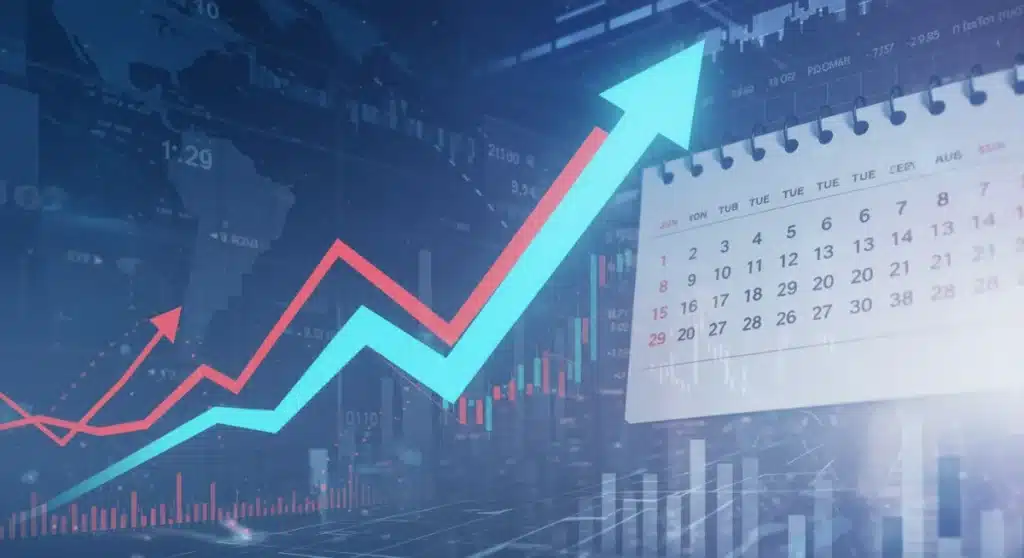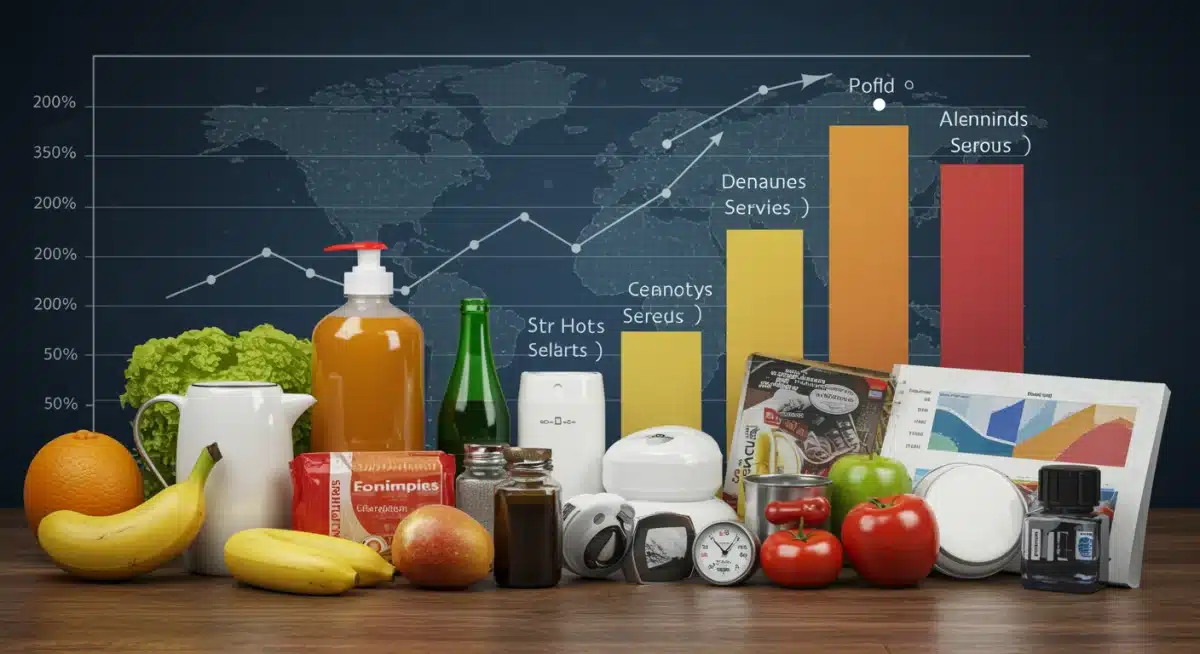Inflation’s Long Game: Forecasting Consumer Spending Habits

Forecasting consumer spending habits for the next 12 months reveals a projected 1.8% growth rate, influenced by persistent inflation and evolving economic factors, shaping market dynamics significantly.
As the economic landscape continues to evolve, understanding Inflation’s Long Game: Forecasting Consumer Spending Habits for the Next 12 Months with a 1.8% Growth Rate becomes paramount. Recent analyses indicate a moderate, yet significant, expansion in consumer outlays. This report delves into the critical factors influencing these projections and what they mean for the broader economy.
Understanding the 1.8% Growth Projection
The projected 1.8% growth in consumer spending over the next 12 months signals a nuanced economic environment. This figure reflects a delicate balance between inflationary pressures and resilient consumer demand. Experts are closely monitoring various indicators to understand the underlying currents driving this forecast.
Several key macroeconomic factors contribute to this specific growth rate. These include employment figures, wage growth, and the overall trajectory of inflation. While inflation remains a concern, its anticipated moderation is expected to allow for some real growth in discretionary spending.
Key Economic Indicators Influencing Spending
A closer look at the data reveals that labor market strength is a primary driver. Steady job creation and modest wage increases provide consumers with the income necessary to maintain spending levels, even as prices rise.
- Employment Stability: Low unemployment rates bolster consumer confidence.
- Wage Growth: Incremental salary increases help offset inflationary impacts.
- Inflationary Trends: A gradual deceleration of inflation is crucial for real spending growth.
Inflation’s Persistent Influence on Consumer Behavior
Inflation continues to play a significant role in shaping how consumers allocate their budgets. While the headline inflation rate may show signs of cooling, its cumulative effect on purchasing power is undeniable. This persistent influence forces consumers to make strategic choices about their expenditures.
Households are increasingly prioritizing essential goods and services, often at the expense of discretionary purchases. This shift in spending patterns is a direct consequence of higher prices for necessities like food, housing, and energy. Businesses must adapt to these evolving preferences to remain competitive.
Adapting to Higher Prices
Consumers are employing various strategies to cope with elevated prices. This includes seeking out sales, opting for store brands, and reducing non-essential spending. The impact is not uniform across all demographics, with lower-income households feeling the squeeze most acutely.
- Budget Reallocation: More funds directed towards necessities.
- Value Seeking: Increased demand for discounts and promotions.
- Brand Loyalty Shifts: Consumers more willing to try less expensive alternatives.
Sector-Specific Spending Trends
Examining consumer spending at a granular level reveals divergent trends across different sectors. While overall growth is projected at 1.8%, some industries are poised for stronger performance, while others may face headwinds. This disparity is largely driven by the nature of goods and services, and their elasticity of demand in an inflationary environment.
Services, particularly those related to travel and entertainment, are expected to see continued, albeit tempered, growth as consumers prioritize experiences. Conversely, big-ticket discretionary items, such as certain electronics or luxury goods, might experience slower growth as consumers become more cautious with large purchases.
Winners and Losers in the Current Climate
The resilience of certain sectors highlights shifts in consumer priorities. For instance, essential services like healthcare and utilities are likely to maintain stable demand, regardless of economic fluctuations. Meanwhile, sectors that rely heavily on discretionary income may need to innovate to attract spending.
- Resilient Sectors: Healthcare, utilities, and essential food items.
- Growth Sectors: Travel, leisure, and personal services showing moderate expansion.
- Challenged Sectors: High-end discretionary retail and durable goods facing headwinds.
The Role of Savings and Credit in Future Spending
Consumer savings rates and credit utilization are critical components in forecasting future spending habits. Post-pandemic, many households accumulated significant savings, which served as a buffer against rising costs. However, these savings have been steadily drawn down, and credit usage has increased.
The current trajectory suggests that consumers are increasingly relying on credit to bridge the gap between their income and rising expenses. While this can sustain spending in the short term, it also raises concerns about household debt levels and future financial stability. The balance between savings depletion and credit accumulation will heavily influence the longevity of consumer spending growth.
Household Financial Dynamics
Monitoring these financial dynamics is crucial for understanding the sustainability of the 1.8% growth rate. A rapid increase in credit card debt, coupled with declining savings, could signal future contraction in spending as households prioritize debt repayment.
- Savings Depletion: Post-pandemic savings are diminishing.
- Credit Reliance: Increased use of credit cards to manage expenses.
- Debt Levels: Rising household debt could impact future spending capacity.

Policy Implications and Economic Outlook
Government policies and central bank actions will undoubtedly shape the consumer spending landscape over the next 12 months. Monetary policy, particularly interest rate decisions, directly impacts borrowing costs for consumers, influencing everything from mortgage payments to credit card interest.
Fiscal policies, such as potential tax adjustments or targeted relief programs, could also inject or withdraw capital from the consumer economy. The interplay between these policy levers and existing economic conditions will be vital in either supporting or hindering the projected 1.8% growth rate. Policymakers face the delicate task of curbing inflation without stifling economic activity.
Government and Central Bank Influence
The Federal Reserve’s stance on interest rates, for instance, has a ripple effect across the economy. Higher rates can cool demand by making borrowing more expensive, while lower rates can stimulate it. The challenge lies in finding the right balance to achieve price stability while fostering sustainable growth.
- Interest Rate Decisions: Directly impacts consumer borrowing and spending.
- Fiscal Measures: Tax policies and government spending can stimulate or slow demand.
- Regulatory Environment: Changes in regulations can affect business costs and consumer prices.
Long-Term Consumer Behavior Shifts
Beyond the immediate 12-month forecast, it is important to consider how consumer behaviors are shifting in the long term. The experience of sustained inflation and economic uncertainty is likely to instill more cautious and value-driven spending habits. This could lead to a permanent recalibration of consumer priorities and expectations.
Digitalization continues to transform how consumers shop and interact with brands. The convenience of online shopping, coupled with data-driven personalization, means that businesses must continuously innovate their digital presence. Environmental and social consciousness also play an increasing role, with consumers gravitating towards brands that align with their values.
Evolving Consumer Preferences
These long-term shifts suggest a future where adaptability and ethical considerations become increasingly important for businesses. Consumers are not just looking for products; they are looking for solutions that align with their lifestyle and values, often prioritizing sustainability and social responsibility.
- Digital Adoption: Continued reliance on e-commerce and online services.
- Value-Consciousness: Emphasis on durability, utility, and cost-effectiveness.
- Ethical Consumption: Growing preference for sustainable and socially responsible brands.
| Key Point | Brief Description |
|---|---|
| 1.8% Growth Forecast | Consumer spending is projected to grow moderately over the next 12 months, balancing inflation and demand. |
| Inflationary Pressures | Persistent inflation continues to influence purchasing power and household budget allocations. |
| Sectoral Divergence | Spending trends vary significantly across industries, with services showing resilience and discretionary goods facing challenges. |
| Policy Impact | Government and central bank policies, particularly interest rates, are critical in shaping future spending patterns. |
Frequently Asked Questions About Consumer Spending
The primary factor driving the 1.8% consumer spending growth forecast is a combination of resilient labor market conditions and modest wage growth. These elements provide consumers with the necessary income to sustain their spending, even in an environment of elevated prices, offering a delicate balance for economic stability.
Inflation directly erodes consumer purchasing power by increasing the cost of goods and services. This means that each dollar buys less, forcing consumers to reallocate their budgets, often prioritizing essentials and reducing discretionary spending. Businesses must adapt by offering value or risk losing market share.
Sectors providing essential services, such as healthcare and utilities, are expected to perform robustly due to inelastic demand. Additionally, services related to travel and leisure are anticipated to show moderate growth as consumers continue to prioritize experiences, albeit with a focus on value and budget-friendly options.
Savings accumulated post-pandemic initially buffered consumer spending against inflation. However, as these savings deplete, consumers are increasingly relying on credit. While credit can sustain short-term spending, a rise in household debt could impact future financial stability and potentially lead to a contraction in spending.
Government policies, including central bank interest rate decisions and fiscal measures like tax adjustments, significantly influence consumer spending. Higher interest rates can deter borrowing and spending, while targeted relief or tax cuts can stimulate it. These policies are crucial for balancing inflation control with economic growth.
What Happens Next
The next 12 months will be a critical period for observing how these forecasted consumer spending habits unfold. Policymakers will continue to navigate the complex economic landscape, with decisions on interest rates and fiscal stimulus directly impacting household budgets. Businesses, in turn, must remain agile, adapting their strategies to meet evolving consumer demands and price sensitivities. The interplay of inflation, employment, and policy will ultimately determine if the 1.8% growth rate is sustained, exceeded, or falls short, profoundly affecting the broader economic outlook.



